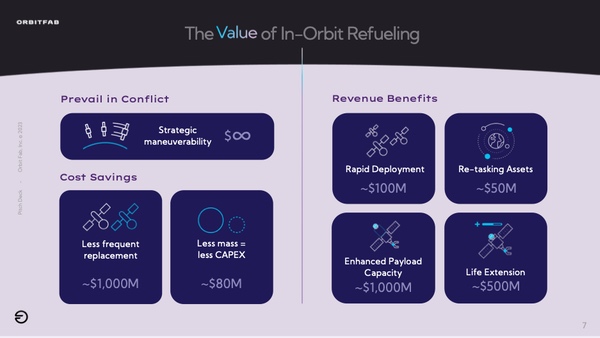
How orbital refueling will unlock humanity’s potential in spaceby Manny Shar
|
| With refueling, spacecraft can instead be designed for increased payload capacity and more capable scientific instruments, thereby fundamentally increasing their value-generating potential. |
2. Extended mission lifespan: The most obvious benefit of refueling is the ability to extend mission duration. Spacecraft, whether satellites, crewed missions, or probes, are constrained by their fuel capacity. Once its fuel is expended, the mission ends and the satellite often becomes space debris. Refueling allows these assets to extend their operational life, making missions more flexible and cost-effective.
3. Increased payload capabilities: Currently, spacecraft must carry all the fuel they will ever use from the moment they launch. With refueling, spacecraft can instead be designed for increased payload capacity and more capable scientific instruments, thereby fundamentally increasing their value-generating potential.
4. Enhanced exploration opportunities: In-space refueling can be a boon for deep space exploration. As we set our sights on destinations like Mars and beyond, the capability to refuel vehicles on their journey becomes a strategic advantage, reducing the need for excessively large and heavy launch vehicles. SpaceX’s Starship, for example, is being designed with refueling from the outset, with multiple refuelings envisioned to enable Artemis crewed lunar landings.
5. Ensuring space sustainability and debris mitigation: Instead of decommissioning satellites when they run out of fuel and potentially contributing to the growing space debris problem, satellites can be refueled and maintained, reducing waste. This is not only an economic advantage but also a major step toward space sustainability. Where satellites do become debris, the costs to remove multiple debris objects can be reduced by up to 80% by incorporating refueling to amortize costs over multiple missions.
6. Maximizing economic viability: As the in-space refueling infrastructure grows, a new industry will emerge. Just as gas stations became a staple for cars, so too will refueling stations for spacecraft. This offers new economic opportunities, from fuel production and transport to the establishment and maintenance of refueling stations across strategic orbits.
 |
While the potential benefits of in-space refueling are apparent, realizing them demands innovation, investment, and, importantly, collaboration across sectors. The public and private sectors, researchers, policymakers, and the public all have roles to play.
Investment in R&D: Governments and private enterprises must channel resources into researching and developing the technology necessary for safe and efficient in-space refueling. Technical de-risking is key to enabling a vibrant in space economy. The recently announced funding by the US Space Force to co-fund a refueling mission is a strong and timely statement of intent in this direction for defense needs. On the civil side, continuing the UK ADR program with a follow-on refueling mission would be a natural next step and cement UK leadership in in-orbit servicing.
Policy frameworks: Spacefaring nations should collaborate to develop regulatory frameworks to oversee this emerging industry and incentivize good behavior, ensuring safety, equity, and sustainability. The UK should build on the recent momentum of the Artemis Accords and the Astra Carta Charter to pave the way for strong frameworks for ensuring space sustainability, working closely with the international community.
| In-space refueling is not just a novel concept; it’s a pivotal component of our future in space. It represents a shift from short-lived, one-off missions to a sustainable, enduring presence in space. |
Public engagement: As stewards of our planet and its immediate space environment, the public should be informed and engaged. They can support policies that drive forward these technologies and advocate for sustainable practices in space. National space agencies should fully advocate and champion space and develop novel campaigns for raising awareness of the crucial role space plays in society today.
Collaboration: Space agencies, private companies, and international bodies need to collaborate on standards, safety protocols, and joint missions to ensure the industry’s growth. Initiatives like CONFERS are an important route through which to convene stakeholders, build consensus, and ensure momentum around critical in-orbit servicing issues that will drive activities in space over the coming decades.
In-space refueling is not just a novel concept; it’s a pivotal component of our future in space. It represents a shift from short-lived, one-off missions to a sustainable, enduring presence in space. Companies like Orbit Fab are leading the way in making this a viable technology having conducted multiple demo missions with support from both the US and UK governments through technology de-risking projects, with plans to demonstrate end-to-end refueling by 2025.
Just as Tesla transformed electric mobility, and Uber disrupted transportation, Orbit Fab is redefining how we approach space operations and exploration. In-space refueling is opening an era where distance and duration in space are no longer constraints. By supporting the development and adoption of these technologies, we're not just investing in space but in a sustainable and interconnected future above and beyond our planet.
Let's embark on this journey together, ensuring that as we reach for the stars, we do so responsibly, sustainably, and inclusively.
Note: we are using a new commenting system, which may require you to create a new account.